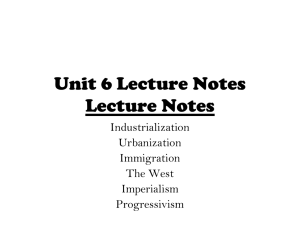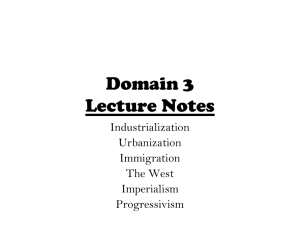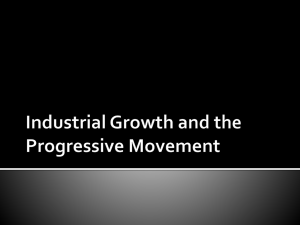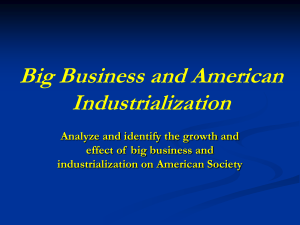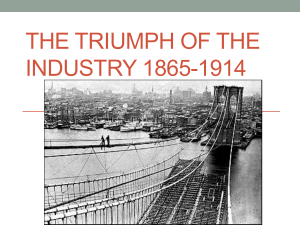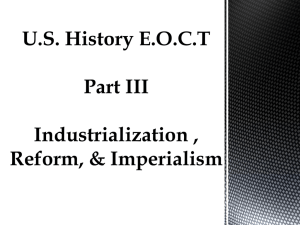Late 19th Century Study Guide
advertisement
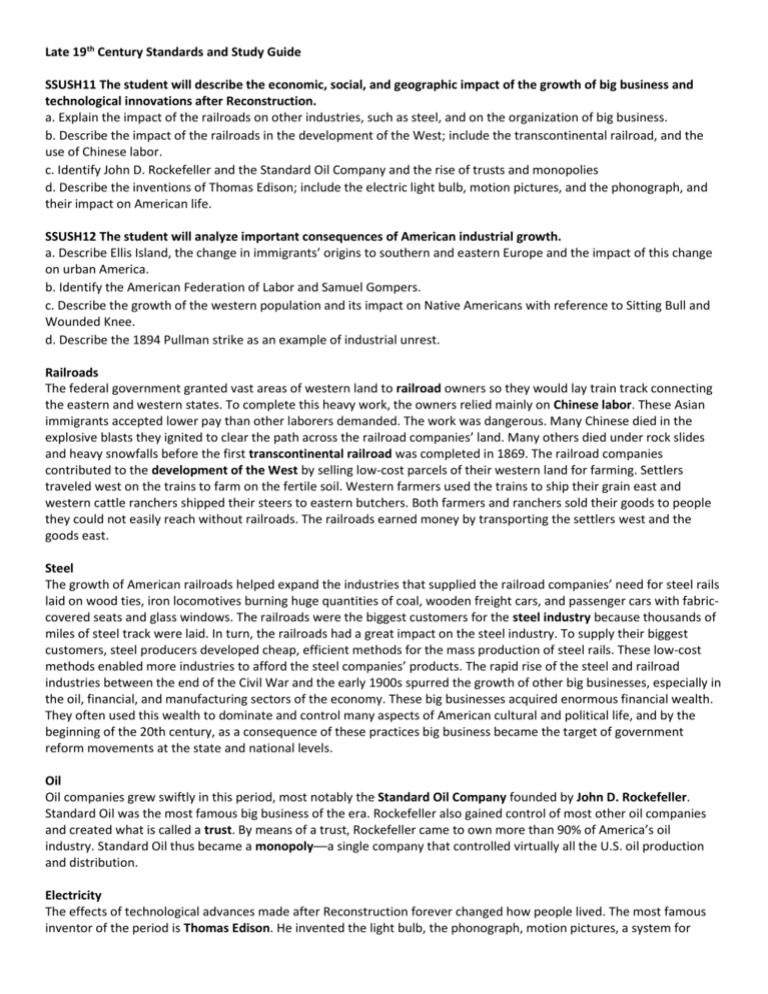
Late 19th Century Standards and Study Guide SSUSH11 The student will describe the economic, social, and geographic impact of the growth of big business and technological innovations after Reconstruction. a. Explain the impact of the railroads on other industries, such as steel, and on the organization of big business. b. Describe the impact of the railroads in the development of the West; include the transcontinental railroad, and the use of Chinese labor. c. Identify John D. Rockefeller and the Standard Oil Company and the rise of trusts and monopolies d. Describe the inventions of Thomas Edison; include the electric light bulb, motion pictures, and the phonograph, and their impact on American life. SSUSH12 The student will analyze important consequences of American industrial growth. a. Describe Ellis Island, the change in immigrants’ origins to southern and eastern Europe and the impact of this change on urban America. b. Identify the American Federation of Labor and Samuel Gompers. c. Describe the growth of the western population and its impact on Native Americans with reference to Sitting Bull and Wounded Knee. d. Describe the 1894 Pullman strike as an example of industrial unrest. Railroads The federal government granted vast areas of western land to railroad owners so they would lay train track connecting the eastern and western states. To complete this heavy work, the owners relied mainly on Chinese labor. These Asian immigrants accepted lower pay than other laborers demanded. The work was dangerous. Many Chinese died in the explosive blasts they ignited to clear the path across the railroad companies’ land. Many others died under rock slides and heavy snowfalls before the first transcontinental railroad was completed in 1869. The railroad companies contributed to the development of the West by selling low-cost parcels of their western land for farming. Settlers traveled west on the trains to farm on the fertile soil. Western farmers used the trains to ship their grain east and western cattle ranchers shipped their steers to eastern butchers. Both farmers and ranchers sold their goods to people they could not easily reach without railroads. The railroads earned money by transporting the settlers west and the goods east. Steel The growth of American railroads helped expand the industries that supplied the railroad companies’ need for steel rails laid on wood ties, iron locomotives burning huge quantities of coal, wooden freight cars, and passenger cars with fabriccovered seats and glass windows. The railroads were the biggest customers for the steel industry because thousands of miles of steel track were laid. In turn, the railroads had a great impact on the steel industry. To supply their biggest customers, steel producers developed cheap, efficient methods for the mass production of steel rails. These low-cost methods enabled more industries to afford the steel companies’ products. The rapid rise of the steel and railroad industries between the end of the Civil War and the early 1900s spurred the growth of other big businesses, especially in the oil, financial, and manufacturing sectors of the economy. These big businesses acquired enormous financial wealth. They often used this wealth to dominate and control many aspects of American cultural and political life, and by the beginning of the 20th century, as a consequence of these practices big business became the target of government reform movements at the state and national levels. Oil Oil companies grew swiftly in this period, most notably the Standard Oil Company founded by John D. Rockefeller. Standard Oil was the most famous big business of the era. Rockefeller also gained control of most other oil companies and created what is called a trust. By means of a trust, Rockefeller came to own more than 90% of America’s oil industry. Standard Oil thus became a monopoly––a single company that controlled virtually all the U.S. oil production and distribution. Electricity The effects of technological advances made after Reconstruction forever changed how people lived. The most famous inventor of the period is Thomas Edison. He invented the light bulb, the phonograph, motion pictures, a system for distributing electrical power, and many other technologies powered by electricity. Edison also established the concept of industrial research and founded a research laboratory staffed by engineers and technicians in New Jersey. Edison’s technological achievements were used by other inventors as evidenced by the development of long-distance electricity transmission that enabled Edison’s electric light to illuminate buildings, streets, and neighborhoods across the United States. Electricity soon replaced steam as the source of power for factories. It replaced horses as the means to power streetcars. Of greatest impact, perhaps, was electricity’s replacing humans as the source of power for household appliances. Edison’s inventions eliminated much manual labor that had been associated with everyday household activities and improved Americans’ quality of life. Old Conflicts Continue As eastern regions of the United States became more industrialized after the Civil War, people seeking rural livelihoods moved farther and farther west. In turn, Native Americans had to compete with these newcomers for land. For example, the Sioux signed a treaty with the U.S. government promising “no white person or persons shall be permitted to settle upon or occupy” Sioux territory in the Dakotas but, when gold was discovered there, the government tried to buy the land from the Sioux, who refused to sell it. The Sioux leader, Sitting Bull, then fought U.S. Army troops, led his people to a brief exile in Canada, and finally agreed to settle on a reservation. About 10 years later, Sitting Bull’s people became associated with a Sioux religious movement. The Native Americans believed their ceremonies would cleanse the world of evil, including the white man, and restore the Sioux’s lost greatness. Government officials ordered Sitting Bull’s arrest. He died in a brief gun battle. After Sitting Bull died, several hundred of his people fled to an area of South Dakota called Wounded Knee. U.S. soldiers went there to confiscate weapons from the Sioux. A gun was fired––nobody knows by whom––and U.S soldiers then opened machine-gun fire, killing more than 300 Sioux. This ended the Native Americans’ long conflict against Americans settling Native American lands. New Immigrants In the decades after the Civil War, more and more Europeans immigrated to America. They differed from earlier immigrant groups who mostly came from northern and western Europe, were typically Protestant, spoke English, and arrived with the government’s welcome. In contrast, many of the new immigrants came from eastern and southern Europe, often were Jewish or Catholic, and usually spoke no English. The U.S. government welcomed the wealthy among these new immigrants but forced poorer people to pass health and welfare tests at government reception centers such as the Ellis Island Immigrant Station located in New York Harbor. Whether Asian or European, these new immigrants tended to settle in areas populated by people from the same countries who spoke the same languages and worshipped in the same ways. Because poverty and political instability were common in their home countries, the new immigrants were likely to be poor. They could not afford to buy farmland, so they worked as unskilled laborers and lived mostly in cities. There they created communities to imitate the cultures of their home countries, including foreign-language newspapers, ethnic stores and restaurants, and houses of worship. The new immigrants did not blend into American society the way earlier immigrants had. American Federation of Labor and Samuel Gompers Unskilled laborers were subject to low wages, long workdays, no vacations, and unsafe workplaces. Because individual workers had little power to change the way an employer ran a business, workers banded together in labor unions to demand better pay and working conditions. Then the labor unions banded together for even more power to change the ways employers ran their businesses. The American Federation of Labor, or AFL, was led by Samuel Gompers. He was president of the AFL from 1886 to 1894 and from 1895 to his death in 1924. His goal was to use strikes (work stoppages) to convince employers to give workers shorter work days, better working conditions, higher wages, and greater control over how they carried out their workplace responsibilities. Pullman Strike During poor economic times in the 1870s and 1890s, violence erupted when employers sought to fire some workers and lower the wages of those still employed. In 1894, when the Pullman railcar factory near Chicago fired almost half its workforce and cut wages by 25% to 50%, its workers went on strike. Other railway workers refused to switch Pullman cars on or off trains. Rail traffic west of Chicago came to a halt. The Pullman company responded by hiring new workers but they were attacked by strikers when they attempted to go to work. Leaders of the railroad industry convinced the government to declare the situation illegal. President Grover Cleveland sent the U.S. Army to restore peace. Big business and the U.S. government both feared labor unions were a menace to America’s capitalist economy.
